The Microsoft Surface Laptop 3 Showdown: AMD's Ryzen Picasso vs. Intel's Ice Lake
by Brett Howse & Andrei Frumusanu on December 13, 2019 8:30 AM ESTGPU Performance - Vega vs Iris
After many tests, it is very clear that Intel’s Ice Lake platform offers a significantly faster CPU, and the results were unsurprising. Although the Ryzen Mobile 3000 platform did launch in 2019, it already struggled on CPU tests against the older Skylake core processors. But on the GPU side, Intel is the one that needs to play catch-up. Previous to Ice Lake, Intel’s standard GT2 GPU platform, found on almost all U-Series 15-Watt processors, offered 24 execution units of their Gen 9.5 GPU. AMD squeezed their Vega GPU architecture into their Ryzen SoC, which could easily double the performance of the Gen 9.5 GT2 GPU.
Ice Lake is Intel’s first real attempt to make a powerful iGPU a standard feature for their CPUs, although it is only a first step. But the new Gen 11 architecture brings some improvements such as more advanced tile-based rendering, variable rate shading, and of course the LPDDR4X-3733 memory adding significant bandwidth, greatly helping the GPU. The biggest change though is just how much die space Intel has dedicated to graphics, jumping from 24 EUs on a full GT2 to 64 EUs on a full GT2 part such as the Core i7-1065G7. And, following in AMD’s footsteps again, Intel is offering cut-down GPUs on lower-spec processors. It’s confused their already confusing processor naming, but the lowest-spec Core announced so far still has 32 EUs, meaning it is still better than the previous gen even at the “G1” level.
AMD has some tricks up their sleeves as well. For the Surface Laptop 3, Microsoft requested a slightly more powerful configuration for their Surface-branded processor. While the CPU side matches the same specifications as the non-Surface CPUs, Microsoft's processor SKUs add an extra GPU Compute Unit to both its Ryzen 5 and Ryzen 7, bringing them to 9 and 11 respectively. So the Surface Laptop 3 should be the best possible showcase for GPU performance on the 3000 series Ryzen mobile APU.
Before the results, let’s go over the driver situation. The Intel system ships with an updated driver over what we used on the Dell XPS 13 2-in-1, which resolves the 3DMark issues we saw on that laptop. The driver is from 2019-11-06 and is version 26.20.100.7463. The AMD platform’s driver is from 2019-10-07 and is version 26.20.12027.5004. Unfortunately, the AMD driver can’t be updated from AMD directly, and instead will be released by Microsoft. The current driver has some quirks, so an updated driver is needed for usability, but it did not prevent any GPU workloads from being run. But, the AMD system would only output 1280x720 where we normally test at 1366x768, and attempts to output to an external monitor were thwarted by the buggy driver, so be aware that in most of the gaming tests, the AMD system was outputting at a slightly lower resolution.
Let’s see how the do starting with some synthetics, and then moving to some real-world games.
3DMark
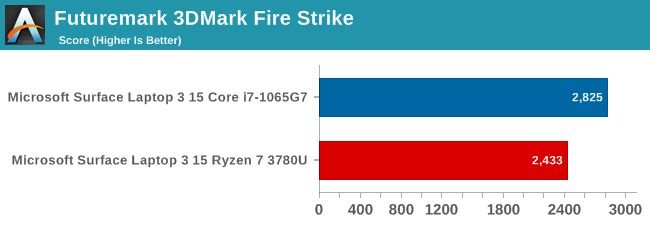
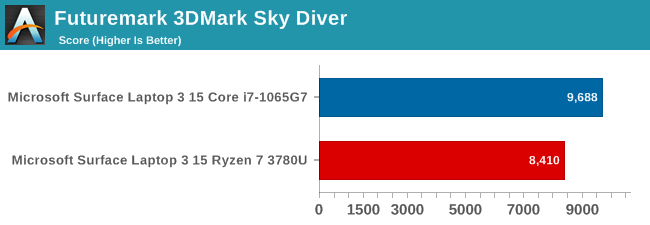
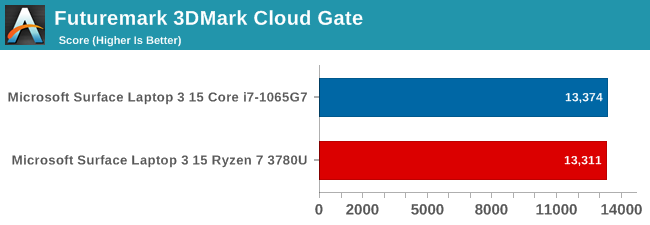
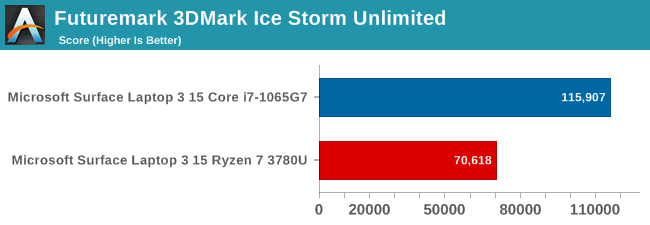
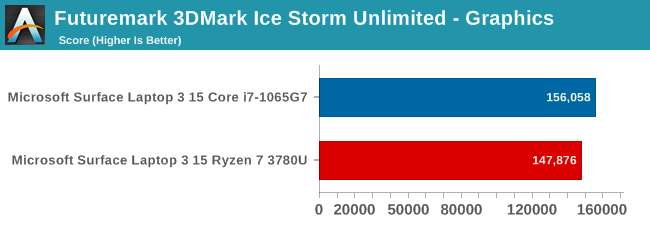
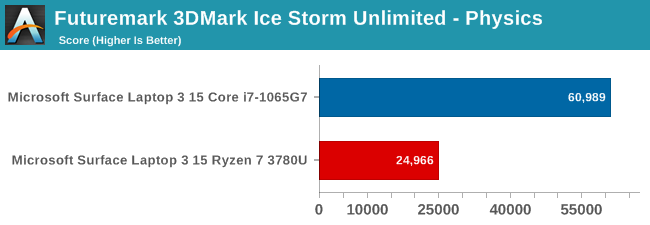
3DMark offers several tests of varying complexity, from Fire Strike as the most demanding, to Ice Storm Unlimited, which can be run on tablets. Here the Ice Lake platform pulls ahead, with better CPU performance helping quite a bit, although the Ice Lake’s Iris Plus graphics is also able to outperform Vega 11 as well.
GFXBench

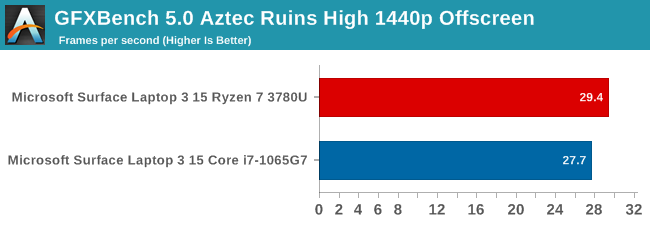
Kishonti’s latest GFXBench suite added DirectX 12 tests to the fold, making it far more relevant than the older OpenGL versions available on the desktop previously. AMD’s previous work in low-level drivers when they developed Mantle has provided the groundwork for DX12 as well, with Vega 11 offering slightly better results than Iris Plus in this test.
Tomb Raider

Running at our value settings, Tomb Raider was easily playable on both systems, with framerates approaching 100 FPS. The Ice Lake platform performed better on this test.
Rise of the Tomb Raider
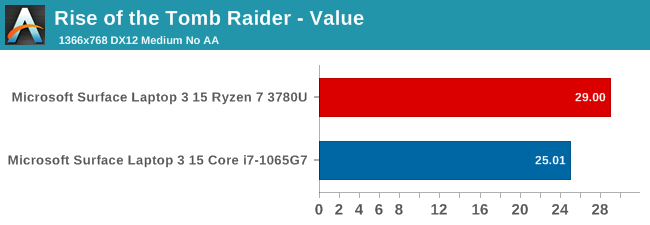
The second installment in the Tomb Raider series offers much more demanding visuals, and both systems struggle to play it at our value settings. The DirectX 12 title performs slightly better on Vega, and with some additional settings tweaks, the game would be playable, which is not something you could have said on an integrated GPU previous to Ryzen and Ice Lake.
Strange Brigade
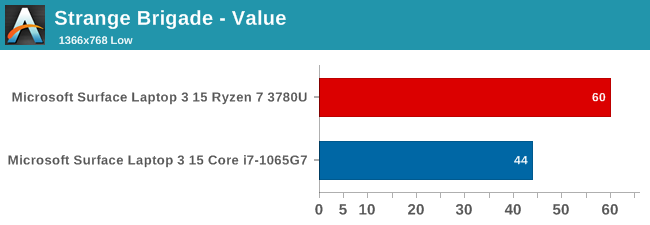
A new title we’re bringing to our laptop suite is Strange Brigade, which scales down nicely on integrated graphics. This game also supports DirectX 12, and as tends to be the pattern, performs very well on Vega 11.
F1 2017
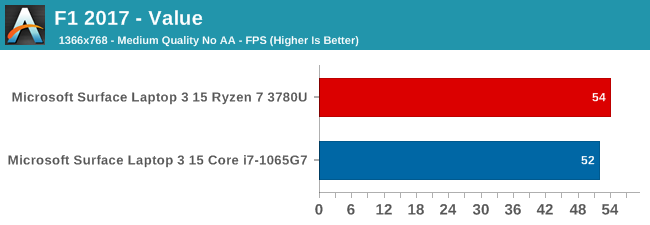
Back with a DirectX 11 title, we see that Intel has again closed the gap, and this game tends to be somewhat CPU bottlenecked as well, so the Sunny Cove cores likely help out here too, but once again Vega 11 wins, if only by a nose.
F1 2019
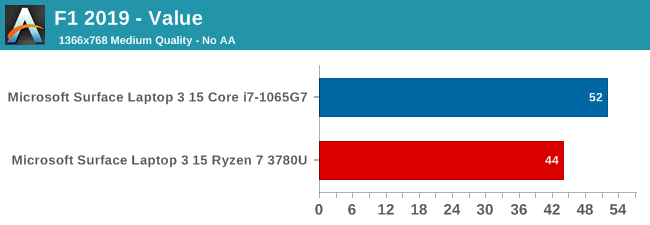
Codemasters updated the underlying EGO engine to support DirectX 12, which was utilized on this test. Despite that, the Vega 11 GPU is a bit slower than the Iris Plus in this test.
Far Cry 5
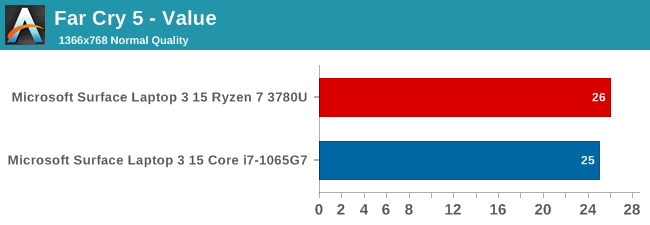
Both systems are within striking distance of being playable, which is somewhat remarkable since the Far Cry series is one of the most popular AAA first-person shooters. The Vega 11 GPU was slightly ahead, which is somewhat surprising as this game tends to be CPU bound, but clearly at this low of a GPU limit that hasn’t come into play yet.










174 Comments
View All Comments
Zoolook - Saturday, December 21, 2019 - link
LP memory uses half size channels compared to regular DDR among other things, if you haven't designed your controller for it, it won't work, and since LP memory has only been used in the mobile sector earlier there was no reason for AMD to design the controller with that in mind.Extra transistors that could be used better elsewhere.
RSAUser - Friday, December 13, 2019 - link
Remember this is Zen gen 1, when they still had the RAM frequency scaling issue vs infinity fabric.sorten - Friday, December 13, 2019 - link
Whoa, nice surprise for a Friday morning! Thanks for the review.Results are about what I expected, and I guess this was the risk for AMD pushing out their previous gen APU for a high profile product. I hope they get the Zen 2 APUs into products soon.
coder543 - Friday, December 13, 2019 - link
Microsoft really should have waited until mobile Zen 2.sing_electric - Friday, December 13, 2019 - link
Honestly, I have no earthly clue why MS makes most of the choices it does with its hardware products. They launched the Surface Studio with a Maxwell GPU right after Pascal came out... then waited 2 years until after Turing was out to update the machine with the Pascal GPUs they should have had at launch. For a machine that is theoretically for "creators" (though, let's be honest, is probably mostly found on the desk of the boss of whoever is actually doing the creating).They did the same thing with the ARM-based Surface Pro X with a custom chip based on the already-year-old Qualcomm 8cx. Honestly, the bigger surprise is that the updated Surface Pro series actually uses current-gen Intel chips soon after they launched.
tipoo - Thursday, December 19, 2019 - link
Bet the Studio 3 comes out right before Ampere too. I agree, sometimes it seems like they're deliberately making themselves a bit less appealing not to piss off their partners.TheinsanegamerN - Friday, December 13, 2019 - link
And miss all the holiday sales?Here is the issue: AMD's mantra is "wait until X", but when "X" arrives, it is outclassed by the competition, or comes out after the major holiday season. The rest of the world doesnt run on AMD's schedule, and this only hurts AMD. If MS didnt want to use zen+, the consumer model would have simply gone with ice lake.
Zen 2 APUs should have come out when the rest of zen 2 did.
Meteor2 - Friday, December 13, 2019 - link
For sure, but they don't have the money to do the development concurrently. Something had to give.lmcd - Friday, December 13, 2019 - link
More like they don't have the money to hold CPU releases for GPU integrationChiplet arch should fix this and let AMD integrate within the same cycle -- this should, in theory, be the last cycle or second-to-last cycle where AMD ships a previous-generation "APU."
RSAUser - Friday, December 13, 2019 - link
Don't think it was the money for mobile Zen 2, more likely lack of available wafers from TSMC, rather supply Desktop as enthusiast and gamers will then market the product while cashing in profits from Epyc.